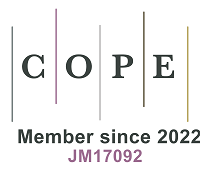REFERENCES
1. Fiedler, H. Dioxins and furans (PCDD/PCDF). In: Fiedler H, editor. Persistent organic pollutants. Berlin/Heidelberg: Springer-Verlag; 2003. pp. 123-201.
2. Harrad, S.; Diamond, M. New directions: exposure to polybrominated diphenyl ethers (PBDEs) and polychlorinated biphenyls (PCBs): current and future scenarios. Atmos. Environ. 2006, 40, 1187-8.
3. Hu, Z.; Yin, L.; Wen, X.; et al. Organophosphate esters in china: fate, occurrence, and human exposure. Toxics 2021, 9, 310.
4. Jian, J. M.; Guo, Y.; Zeng, L.; et al. Global distribution of perfluorochemicals (PFCs) in potential human exposure source - a review. Environ. Int. 2017, 108, 51-62.
5. Fiolet, T.; Casagrande, C.; Nicolas, G.; et al. Dietary intakes of dioxins and polychlorobiphenyls (PCBs) and breast cancer risk in 9 European countries. Environ. Int. 2022, 163, 107213.
6. Ragnarsdóttir, O.; Abdallah, M. A.; Harrad, S. Dermal uptake: an important pathway of human exposure to perfluoroalkyl substances? Environ. Pollut. 2022, 307, 119478.
7. Liu, X.; Yu, G.; Cao, Z.; et al. Estimation of human exposure to halogenated flame retardants through dermal adsorption by skin wipe. Chemosphere 2017, 168, 272-8.
8. Frederiksen, M.; Stapleton, H. M.; Vorkamp, K.; et al. Dermal uptake and percutaneous penetration of organophosphate esters in a human skin ex vivo model. Chemosphere 2018, 197, 185-92.
9. Papadopoulou, E.; Padilla-Sanchez, J. A.; Collins, C. D.; et al. Sampling strategy for estimating human exposure pathways to consumer chemicals. Emerg. Contam. 2016, 2, 26-36.
10. Bao, J.; Ren, H.; Han, J.; Yang, X.; Li, Y.; Jin, J. Levels, tissue distribution and isomer stereoselectivity of Dechlorane Plus in humans: a critical review. Sci. Total. Environ. 2023, 903, 166156.
11. Ojo, A. F.; Peng, C.; Ng, J. C. Assessing the human health risks of per- and polyfluoroalkyl substances: a need for greater focus on their interactions as mixtures. J. Hazard. Mater. 2021, 407, 124863.
12. Wilford, B. H.; Harner, T.; Zhu, J.; Shoeib, M.; Jones, K. C. Passive sampling survey of polybrominated diphenyl ether flame retardants in indoor and outdoor air in Ottawa, Canada: implications for sources and exposure. Environ. Sci. Technol. 2004, 38, 5312-8.
13. Ma, Y.; Stubbings, W. A.; Abdallah, M. A.; Cline-Cole, R.; Harrad, S. Formal waste treatment facilities as a source of halogenated flame retardants and organophosphate esters to the environment: a critical review with particular focus on outdoor air and soil. Sci. Total. Environ. 2022, 807, 150747.
14. Cao, Z.; Xu, X.; Zhao, Y.; et al. Gas-particle partition and size-segregated distribution of flame retardants in indoor and outdoor air: reevaluation on the role of fine particles in human exposure. Chemosphere 2022, 292, 133414.
15. Massolo, L.; Rehwagen, M.; Porta, A.; Ronco, A.; Herbarth, O.; Mueller, A. Indoor-outdoor distribution and risk assessment of volatile organic compounds in the atmosphere of industrial and urban areas. Environ. Toxicol. 2010, 25, 339-49.
16. Wang, J.; Wang, Y.; Shi, Z.; Zhou, X.; Sun, Z. Legacy and novel brominated flame retardants in indoor dust from Beijing, China: occurrence, human exposure assessment and evidence for PBDEs replacement. Sci. Total. Environ. 2018, 618, 48-59.
17. Li, J.; Dong, Z.; Wang, Y.; et al. Human exposure to brominated flame retardants through dust in different indoor environments: identifying the sources of concentration differences in hair from men and women. Chemosphere 2018, 205, 71-9.
18. Chormare, R.; Kumar, M. A. Environmental health and risk assessment metrics with special mention to biotransfer, bioaccumulation and biomagnification of environmental pollutants. Chemosphere 2022, 302, 134836.
19. Katagi, T. Bioconcentration, bioaccumulation, and metabolism of pesticides in aquatic organisms. Rev. Environ. Contam. Toxicol. 2010, 204, 1-132.
20. Haglund, P.; Alygizakis, N. A.; Covaci, A.; et al. Comprehensive characterization of European house dust contaminants: concentrations and profiles, geographical variability, and implications for chemical regulation and health risk. Sci. Total. Environ. 2024, 957, 177639.
21. Wang, S.; Romanak, K. A.; Stubbings, W. A.; et al. Silicone wristbands integrate dermal and inhalation exposures to semi-volatile organic compounds (SVOCs). Environ. Int. 2019, 132, 105104.
22. Crump, D. Application of diffusive samplers. In: Organic indoor air pollutants: occurrence, measurement, evaluation. Wiley‐VCH Verlag GmbH & Co. KGaA; 2009. pp. 47-63.
23. Ma, Y. Temporal changes in halogenated flame-retardant concentrations in foodstuffs and indoor and outdoor environments: implications for human exposure. 2024. https://etheses.bham.ac.uk/id/eprint/14486/. (accessed 27 Jun 2025).







